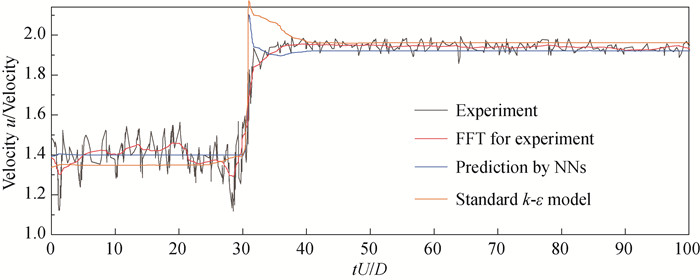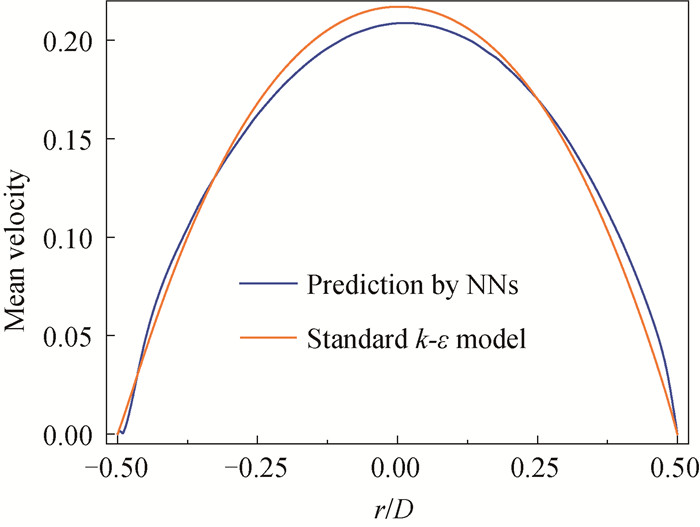计算物理 ›› 2023, Vol. 40 ›› Issue (1): 57-66.DOI: 10.19596/j.cnki.1001-246x.8517
梁炜光( ), 桑建兵*(
), 桑建兵*( ), 田红艳, 段文杰, 陶雅萍, 李烽韬
), 田红艳, 段文杰, 陶雅萍, 李烽韬
收稿日期:2022-02-19
出版日期:2023-01-25
发布日期:2023-07-04
通讯作者:
桑建兵
作者简介:梁炜光,男,硕士,研究方向为工程结构分析与智能算法研究,E-mail: 381973887@qq.com
基金资助:
Weiguang LIANG( ), Jianbing SANG*(
), Jianbing SANG*( ), Hongyan TIAN, Wenjie DUAN, Yaping TAO, Fengtao LI
), Hongyan TIAN, Wenjie DUAN, Yaping TAO, Fengtao LI
Received:2022-02-19
Online:2023-01-25
Published:2023-07-04
Contact:
Jianbing SANG
摘要:
为提高RANS湍流模型数值模拟的精度,基于人工神经网络对RANS中标准k-ε湍流模型系数进行预测与修正,并对受壁面射流扰动的管道流场进行分析。首先建立管道流的有限元模型,同时考虑壁面射流对管内流体流动状态的影响,对管道流的流动进行有限元仿真,得到管道流受扰动后的速度场分布。其次,搭建预测标准k-ε湍流模型系数的神经网络模型,预测描述管道内速度场变化趋势的标准k-ε湍流模型系数。最后, 将新的系数带入有限元模型计算,并与实验数据对比,发现修正后的湍流模型对管道各部分速度场的模拟精度均有较大提升,对标准k-ε湍流模型系数的预测与修正可以提高模型对管道内速度场变化趋势的模拟精度。
梁炜光, 桑建兵, 田红艳, 段文杰, 陶雅萍, 李烽韬. 基于数据驱动管道流体湍流模型的系数修正及流动特性分析[J]. 计算物理, 2023, 40(1): 57-66.
Weiguang LIANG, Jianbing SANG, Hongyan TIAN, Wenjie DUAN, Yaping TAO, Fengtao LI. Flow Characteristic Analysis of Pipe Flow and Turbulence Model Coefficient Correction Based on Data-driven[J]. Chinese Journal of Computational Physics, 2023, 40(1): 57-66.
| 参数 | 值域 | 固定增量 |
| Cμ | [0.04, 0.16] | 0.001 |
| C1ε | [1.2, 1.68] | 0.004 |
| C2ε | [1.68, 2.16] | 0.004 |
| σk | [0.76, 1.24] | 0.004 |
| σε | [1.06, 1.54] | 0.004 |
表1 参数及值域
Table 1 Parameters and their domains in parameter space
| 参数 | 值域 | 固定增量 |
| Cμ | [0.04, 0.16] | 0.001 |
| C1ε | [1.2, 1.68] | 0.004 |
| C2ε | [1.68, 2.16] | 0.004 |
| σk | [0.76, 1.24] | 0.004 |
| σε | [1.06, 1.54] | 0.004 |
| 参数 | MSE | RMSE | MAE | R2 |
| Cμ | 0.000 723 | 0.026 888 | 0.022 188 | 0.973 971 |
| C1ε | 0.001 208 | 0.034 756 | 0.027 804 | 0.969 357 |
| C2ε | 0.001 493 | 0.038 639 | 0.032 515 | 0.965 159 |
| σk | 0.001 084 | 0.032 924 | 0.024 412 | 0.971 609 |
| σε | 0.001 218 | 0.034 899 | 0.028 719 | 0.967 306 |
表2 神经网络预测湍流模型参数的统计指标
Table 2 Statistical indicators of turbulence model parameters
| 参数 | MSE | RMSE | MAE | R2 |
| Cμ | 0.000 723 | 0.026 888 | 0.022 188 | 0.973 971 |
| C1ε | 0.001 208 | 0.034 756 | 0.027 804 | 0.969 357 |
| C2ε | 0.001 493 | 0.038 639 | 0.032 515 | 0.965 159 |
| σk | 0.001 084 | 0.032 924 | 0.024 412 | 0.971 609 |
| σε | 0.001 218 | 0.034 899 | 0.028 719 | 0.967 306 |
| Cμ | C1ε | C2ε | σk | σε |
| 0.083 209 09 | 1.385 580 1 | 1.910 502 9 | 0.971 979 1 | 1.264 098 8 |
表3 神经网络预测的湍流模型控制方程参数
Table 3 Prediction of k-ε turbulent model parameters with NN
| Cμ | C1ε | C2ε | σk | σε |
| 0.083 209 09 | 1.385 580 1 | 1.910 502 9 | 0.971 979 1 | 1.264 098 8 |

图7 基于神经网络修正前后的标准k-ε湍流模型预测的velocity u/velocity曲线与实验数据
Fig.7 Velocity u/velocity curve based on the initial standard k-ε turbulence model, the modified standard k-ε turbulence model and experimental data

图8 基于修正后标准k-ε湍流模型预测的壁面注射流体扰动管内湍流情况下的管道各部分速度场
Fig.8 Velocity field of the pipe predicted with the modified standard k-ε turbulence model with wall injection

图9 基于神经网络修正前后的标准k-ε湍流模型预测的管道下游横截面平均速度
Fig.9 Mean velocity of downstream cross-section of the pipe based on the initial and modified standard k-ε turbulence model
| 1 |
|
| 2 |
|
| 3 |
|
| 4 |
|
| 5 |
DOI |
| 6 |
|
| 7 |
DOI |
| 8 |
|
| 9 |
|
| 10 |
|
| 11 |
KURBATSKⅡ K. Comparison of RANs turbulence models in numerical prediction of chevron nozzle jet flows[C]//47th AIAA Aerospace Sciences Meeting Including The New Horizons Forum and Aerospace Exposition, 2009: 499.
|
| 12 |
DOI |
| 13 |
|
| 14 |
谢晨月, 袁泽龙, 王建春, 等. 基于人工神经网络的湍流大涡模拟方法[J]. 力学学报, 2021, 53 (1): 1- 16.
|
| 15 |
DOI |
| 16 |
REDDY S B, MAGEE A R, JAIMAN R K, et al. Reduced order model for unsteady fluid flows via recurrent neural networks[C]. International Conference on Offshore Mechanics and Arctic Engineering, American Society of Mechanical Engineers, 2019, 58776: V002T08A007.
|
| 17 |
RAJENDRAN V, KELLY K Y, LEONARDI E, et al. Vortex detection on unsteady CFD simulations using recurrent neural networks[C]. 2018 Fluid Dynamics Conference, 2018: 3724.
|
| 18 |
DOI |
| 19 |
DOI |
| 20 |
郭先文, 夏振华, 陈十一. 基于RANS模型的数据增强在数据驱动湍流模型中的应用[C]. 第十一届全国流体力学学术会议论文摘要集, 2020.
|
| 21 |
张亦知. 基于数据驱动的湍流模型修正方法研究[D]. 上海: 上海交通大学, 2020.
|
| 22 |
张珍, 叶舒然, 岳杰顺, 等. 基于组合神经网络的雷诺平均湍流模型多次修正方法[J]. 力学学报, 2021, 53 (6): 1532- 1542.
|
| 23 |
SMITH E J, MI J, NATHAN G J, et al. Preliminary examination of a "round jet initial condition anomaly" for the k-ε turbulence model[C]. 15th Australasian Fluid Mechanics Conference, Sydney: The University of Sydney, 2004: 1-4.
|
| 24 |
DOI |
| 25 |
DOI |
| 26 |
DOI |
| 27 |
付晨博. 标准k-ε湍流模型在平面尾流中的改进[D]. 哈尔滨: 哈尔滨工业大学, 2019.
|
| 28 |
|
| 29 |
|
| 30 |
|
| 31 |
|
| [1] | 张僡凤, 欧阳洁, 代向艳. 耦合有限体积法的Brown构型场并行算法[J]. 计算物理, 2012, 29(1): 17-24. |
| [2] | 李旭, 俞集辉, 李永明, 汪泉弟. 互连导线串扰问题的人工神经网络预测[J]. 计算物理, 2009, 26(2): 311-316. |
| [3] | 孔繁敏, 冯存峰, 张学尧, 傅宇, 张乃健, 何瑁, 王承瑞, 谭有恒. 羊八井ARGO实验中原初γ和质子的区分[J]. 计算物理, 2000, 17(3): 280-285. |
| [4] | 陈国新, 张承福. 一种快速分类的神经元网络算法[J]. 计算物理, 1995, 12(2): 203-206. |
| 阅读次数 | ||||||
|
全文 |
|
|||||
|
摘要 |
|
|||||
版权所有 © 《计算物理》编辑部
地址:北京市海淀区丰豪东路2号 邮编:100094 E-mail:jswl@iapcm.ac.cn
本系统由北京玛格泰克科技发展有限公司设计开发
